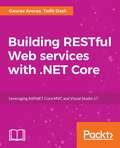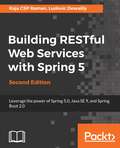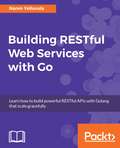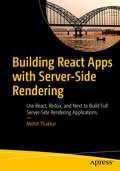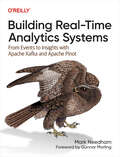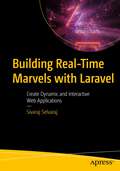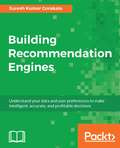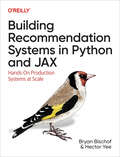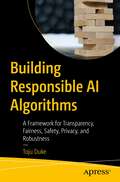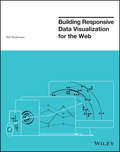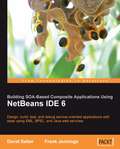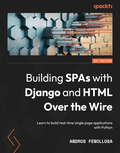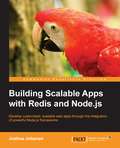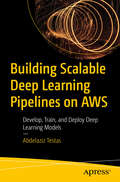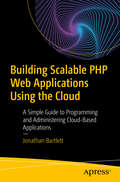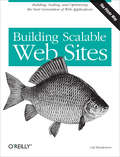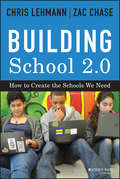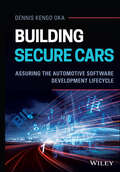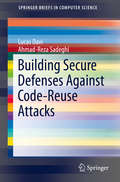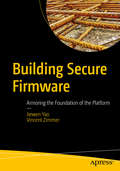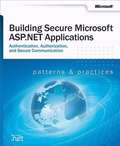- Table View
- List View
Building RESTful Web Services with .NET Core: Developing Distributed Web Services to improve scalability with .NET Core 2.0 and ASP.NET Core 2.0
by Gaurav Aroraa Tadit DashBuilding Complete E-commerce/Shopping Cart ApplicationKey FeaturesFollow best practices and explore techniques such as clustering and caching to achieve a reactive, scalable web serviceLeverage the .NET Framework to quickly implement RESTful endpoints.Learn to implement a client library for a RESTful web service using ASP.NET Core.Book DescriptionREST is an architectural style that tackles the challenges of building scalable web services. In today's connected world, APIs have taken a central role on the web. APIs provide the fabric through which systems interact, and REST has become synonymous with APIs. The depth, breadth, and ease of use of ASP.NET Core makes it a breeze for developers to work with for building robust web APIs. This book takes you through the design of RESTful web services and leverages the ASP.NET Core framework to implement these services. This book begins by introducing you to the basics of the philosophy behind REST. You'll go through the steps of designing and implementing an enterprise-grade RESTful web service. This book takes a practical approach, that you can apply to your own circumstances. This book brings forth the power of the latest .NET Core release, working with MVC. Later, you will learn about the use of the framework to explore approaches to tackle resilience, security, and scalability concerns. You will explore the steps to improve the performance of your applications. You'll also learn techniques to deal with security in web APIs and discover how to implement unit and integration test strategies. By the end of the book, you will have a complete understanding of Building a client for RESTful web services, along with some scaling techniques.What you will learn Add basic authentication to your RESTful API Create a Carts Controller and Orders Controller to manage and process Orders Intercept HTTP requests and responses by building your own middleware Test service calls using Postman and Advanced REST Client Secure your data/application using annotationsWho this book is forThis book is intended for those who want to learn to build RESTful web services with the latest .NET Core Framework. To make best use of the code samples included in the book, you should have a basic knowledge of C# and .NET Core.
Building RESTful Web Services with Java EE 8: Create modern RESTful web services with the Java EE 8 API
by Mario-Leander ReimerLearn the fundamentals of Java EE 8 APIs to build effective web servicesKey FeaturesDesign modern and stylish web services with Java EE APIsSecure your web services with JSON Web TokensExplore the advanced concepts of RESTful web services and the JAX-RS API Book DescriptionJava Enterprise Edition is one of the leading application programming platforms for enterprise Java development. With Java EE 8 finally released and the first application servers now available, it is time to take a closer look at how to develop modern and lightweight web services with the latest API additions and improvements.Building RESTful Web Services with Java EE 8 is a comprehensive guide that will show you how to develop state-of-the-art RESTful web services with the latest Java EE 8 APIs. You will begin with an overview of Java EE 8 and the latest API additions and improvements. You will then delve into the details of implementing synchronous RESTful web services and clients with JAX-RS. Next up, you will learn about the specifics of data binding and content marshalling using the JSON-B 1.0 and JSON-P 1.1 APIs.This book also guides you in leveraging the power of asynchronous APIs on the server and client side, and you will learn to use server-sent events (SSEs) for push communication. The final section covers advanced web service topics such as validation, JWT security, and diagnosability.By the end of this book, you will have implemented several working web services and have a thorough understanding of the Java EE 8 APIs required for lightweight web service development.What you will learnDive into the latest Java EE 8 APIs relevant for developing web servicesUse the new JSON-B APIs for easy data bindingUnderstand how JSON-P API can be used for flexible processingImplement synchronous and asynchronous JAX-RS clientsUse server-sent events to implement server-side codeSecure Java EE 8 web services with JSON Web TokensWho this book is forIf you're a Java developer who wants to learn how to implement web services using the latest Java EE 8 APIs, this book is for you. Though no prior knowledge of Java EE 8 is required, experience with a previous Java EE version will be beneficial.
Building RESTful Web Services with Spring 5: Leverage the power of Spring 5.0, Java SE 9, and Spring Boot 2.0
by Ludovic Dewailly Raja Csp RamanFind out how to implement the REST architecture to build resilient software in Java with the help of the Spring 5.0 framework. Key Features ~Follow best practices and explore techniques such as clustering and caching to achieve a reactive, scalable web service,~Leverage the Spring Framework to quickly implement RESTful endpoints,~Learn to implement a client library for a RESTful web service using the Spring Framework along with the new front end framework. Book Description REST is an architectural style that tackles the challenges of building scalable web services. In today's connected world, APIs have taken a central role on the web. APIs provide the fabric through which systems interact, and REST has become synonymous with APIs.The depth, breadth, and ease of use of Spring makes it one of the most attractive frameworks in the Java ecosystem. Marrying the two technologies is therefore a very natural choice.This book takes you through the design of RESTful web services and leverages the Spring Framework to implement these services. Starting from the basics of the philosophy behind REST, you'll go through the steps of designing and implementing an enterprise-grade RESTful web service. Taking a practical approach, each chapter provides code samples that you can apply to your own circumstances.This second edition brings forth the power of the latest Spring 5.0 release, working with MVC built-in as well as the front end framework. It then goes beyond the use of Spring to explores approaches to tackle resilience, security, and scalability concerns. Improve performance of your applications with the new HTTP 2.0 standards. You'll learn techniques to deal with security in Spring and discover how to implement unit and integration test strategies.Finally, the book ends by walking you through building a Java client for your RESTful web service, along with some scaling techniques using the new Spring Reactive libraries. What you will learn Deep dive into the principles behind REST Expose CRUD operations through RESTful endpoints with the Spring Framework Devise response formats and error handling strategies, offering a consistent and flexible structure to simplify integration for service consumers Follow the best approaches for dealing with a service's evolution while maintaining backward compatibility Understand techniques to secure web services Comply with the best ways to test RESTful web services, including tips for load testing Optimise and scale web services using techniques such as caching and clustering Who this book is for This book is intended for those who want to learn to build RESTful web services with the latest Spring 5.0 Framework. To make best use of the code samples included in the book, you should have a basic knowledge of the Java language. Previous experience with the Spring Framework would also help you get up and running quickly.
Building RESTful Web services with Go: Learn how to build powerful RESTful APIs with Golang that scale gracefully
by Anshul Joshi Naren YellavulaKey Features Follow best practices and explore techniques such as clustering and caching to achieve a reactive, scalable web service Leverage the Buffalo Framework to quickly implement RESTful endpoints Learn to implement a client library for a RESTful web service using Go Book Description REST is an architectural style that tackles the challenges of building scalable web services and in today's connected world, APIs have taken a central role on the web. APIs provide the fabric through which systems interact, and REST has become synonymous with APIs. The depth, breadth, and ease of use of Go, makes it a breeze for developers to work with it to build robust Web APIs. This book takes you through the design of RESTful web services and leverages a framework like Buffalo Go to implement these services. The book starts with a brief introduction to REST API development and how it transformed the modern web. You will learn how to handle routing and authentication of web services along with working with middleware for internal service. The book explains how to use Go frameworks to build RESTful web services and work with MongoDB to create REST API. You will learn how to integrate Postgres SQL and JSON with a Go web service and build a client library in Go for consuming REST API. You will learn how to scale APIs using the microservice architecture and deploy the REST APIs using Nginx as a proxy server. Finally you will learn how to metricize a REST API using an API Gateway. By the end of the book you will be proficient in building RESTful APIs in Go. What you will learn Create HTTP handler and introspect the Gorilla Mux router OAuth 2 implementation with Go Build RESTFul API with go-restful, Revel.Go and Buffalo Go Create REST API with MongoDB and Go Build a working client library and unit test for REST API Debug, test, and profile RESTful APIs with each of the frameworks Optimize and scale REST API using microservices
Building React Apps with Server-Side Rendering: Use React, Redux, and Next to Build Full Server-Side Rendering Applications
by Mohit ThakkarLeverage the benefits of both client-side and server-side rendering to get the most out of your React applications. By the end of this book you will be able to build and deploy React applications using the Next.js framework to fully render server-side HTML on every Web page. You'll begin by reviewing JavaScript fundamentals and how they work with the core principles of React. You'll then move on to Next.js, the React framework for server-rendered applications. Using this framework, you will create a fast and secure solutional React application that renders content on the server-side, protects sensitive information, and optimizes response times. Before deploying the application using Docker containers, you'll create automated unit tests to verify that every component is appropriately doing its jobBuilding React Apps with Server-Side Rendering also covers other fun and interesting topics such as Bootstrap 4, JSX (JavaScript XML), adding styling to your React applications, and much more. By the end of this book, you will be able to build and deploy React applications that fully render server-side HTML on every page. In the end you'll have a client-side rendered React application that integrates server-side rendering into it using Next.js framework. What You'll Learn Examine fundamental concepts of JavaScript (ES 2015)Create client-side apps using JavaScript frameworks React and ReduxAdd server-side rendering to React apps using the NextJS Framework Who This Book Is For Web developers who have prior experience in working with JavaScript, HTML and CSS, who wish to step up a level and create better web applications using modern JavaScript frameworks like React, Reduct & Next.
Building Real-Time Analytics Systems: From Events to Insights with Apache Kafka and Apache Pinot
by Mark NeedhamGain deep insight into real-time analytics, including the features of these systems and the problems they solve. With this practical book, data engineers at organizations that use event-processing systems such as Kafka, Google Pub/Sub, and AWS Kinesis will learn how to analyze data streams in real time. The faster you derive insights, the quicker you can spot changes in your business and act accordingly.Author Mark Needham from StarTree provides an overview of the real-time analytics space and an understanding of what goes into building real-time applications. The book's second part offers a series of hands-on tutorials that show you how to combine multiple software products to build real-time analytics applications for an imaginary pizza delivery service.You will:Learn common architectures for real-time analyticsDiscover how event processing differs from real-time analyticsIngest event data from Apache Kafka into Apache PinotCombine event streams with OLTP data using Debezium and Kafka StreamsWrite real-time queries against event data stored in Apache PinotBuild a real-time dashboard and order tracking appLearn how Uber, Stripe, and Just Eat use real-time analytics
Building Real-Time Marvels with Laravel: Create Dynamic and Interactive Web Applications
by Sivaraj SelvarajDive into the diverse facets of the Laravel ecosystem. This comprehensive guide will put you on the fast track to becoming an expert in Laravel development. Starting with the fundamentals, you’ll explore essential concepts, enabling you to grasp the framework's structure. Subsequent chapters cover intricate topics, such as advanced routing techniques, database management, and eloquent object relational mapping (ORM), allowing developers to build robust applications. The book offers comprehensive insights into building secure applications with authentication and authorization mechanisms, as well as constructing efficient APIs and employing caching techniques for enhanced performance. Chapters on real-time applications and queues offer practical knowledge to optimize application responsiveness. Advanced package development and performance monitoring provide valuable tools for developing high-quality Laravel packages and debugging. You’ll also gain expertise in internationalization, front-end development, and database optimization.Building Real-Time Marvels with Laravel doesn't shy away from the latest trends, featuring chapters on serverless computing, progressive web applications (PWAs), and UI/UX design patterns. It also emphasizes security, DevOps, and infrastructure automation. Bonus appendixes feature a handy Laravel cheat sheet, recommended resources, and a glossary of essential terms, making it a comprehensive reference for Laravel enthusiasts.What You Will Learn Gain a comprehensive understanding of advanced routing, database management with eloquent ORM, authentication, and API development.Study caching, database query optimization, queuing, and scaling strategies for high-traffic applicationsExplore advanced middleware, real-time applications, testing, and package development Who This Book Is ForIntermediate to advanced developers.
Building Recommendation Engines
by Suresh Kumar GorakalaUnderstand your data and user preferences to make intelligent, accurate, and profitable decisions About This Book • A step-by-step guide to building recommendation engines that are personalized, scalable, and real time • Get to grips with the best tool available on the market to create recommender systems • This hands-on guide shows you how to implement different tools for recommendation engines, and when to use which Who This Book Is For This book caters to beginners and experienced data scientists looking to understand and build complex predictive decision-making systems, recommendation engines using R, Python, Spark, Neo4j, and Hadoop. What You Will Learn • Build your first recommendation engine • Discover the tools needed to build recommendation engines • Dive into the various techniques of recommender systems such as collaborative, content-based, and cross-recommendations • Create efficient decision-making systems that will ease your work • Familiarize yourself with machine learning algorithms in different frameworks • Master different versions of recommendation engines from practical code examples • Explore various recommender systems and implement them in popular techniques with R, Python, Spark, and others In Detail A recommendation engine (sometimes referred to as a recommender system) is a tool that lets algorithm developers predict what a user may or may not like among a list of given items. Recommender systems have become extremely common in recent years, and are applied in a variety of applications. The most popular ones are movies, music, news, books, research articles, search queries, social tags, and products in general. The book starts with an introduction to recommendation systems and its applications. You will then start building recommendation engines straight away from the very basics. As you move along, you will learn to build recommender systems with popular frameworks such as R, Python, Spark, Neo4j, and Hadoop. You will get an insight into the pros and cons of each recommendation engine and when to use which recommendation to ensure each pick is the one that suits you the best. During the course of the book, you will create simple recommendation engine, real-time recommendation engine, scalable recommendation engine, and more. You will familiarize yourselves with various techniques of recommender systems such as collaborative, content-based, and cross-recommendations before getting to know the best practices of building a recommender system towards the end of the book! Style and approach This book follows a step-by-step practical approach where users will learn to build recommendation engines with increasing complexity in every chapter
Building Recommendation Systems in Python and JAX: Hands-On Production Systems at Scale
by Bryan Bischof Hector YeeImplementing and designing systems that make suggestions to users are among the most popular and essential machine learning applications available. Whether you want customers to find the most appealing items at your online store, videos to enrich and entertain them, or news they need to know, recommendation systems (RecSys) provide the way.In this practical book, authors Bryan Bischof and Hector Yee illustrate the core concepts and examples to help you create a RecSys for any industry or scale. You'll learn the math, ideas, and implementation details you need to succeed. This book includes the RecSys platform components, relevant MLOps tools in your stack, plus code examples and helpful suggestions in PySpark, SparkSQL, FastAPI, and Weights & Biases.You'll learn:The data essential for building a RecSysHow to frame your data and business as a RecSys problemWays to evaluate models appropriate for your systemMethods to implement, train, test, and deploy the model you chooseMetrics you need to track to ensure your system is working as plannedHow to improve your system as you learn more about your users, products, and business case
Building Responsible AI Algorithms: A Framework for Transparency, Fairness, Safety, Privacy, and Robustness
by Toju DukeThis book introduces a Responsible AI framework and guides you through processes to apply at each stage of the machine learning (ML) life cycle, from problem definition to deployment, to reduce and mitigate the risks and harms found in artificial intelligence (AI) technologies. AI offers the ability to solve many problems today if implemented correctly and responsibly. This book helps you avoid negative impacts – that in some cases have caused loss of life – and develop models that are fair, transparent, safe, secure, and robust.The approach in this book raises your awareness of the missteps that can lead to negative outcomes in AI technologies and provides a Responsible AI framework to deliver responsible and ethical results in ML. It begins with an examination of the foundational elements of responsibility, principles, and data. Next comes guidance on implementation addressing issues such as fairness, transparency, safety, privacy, and robustness. The book helps you think responsibly while building AI and ML models and guides you through practical steps aimed at delivering responsible ML models, datasets, and products for your end users and customers. What You Will LearnBuild AI/ML models using Responsible AI frameworks and processesDocument information on your datasets and improve data qualityMeasure fairness metrics in ML modelsIdentify harms and risks per task and run safety evaluations on ML modelsCreate transparent AI/ML modelsDevelop Responsible AI principles and organizational guidelinesWho This Book Is ForAI and ML practitioners looking for guidance on building models that are fair, transparent, and ethical; those seeking awareness of the missteps that can lead to unintentional bias and harm from their AI algorithms; policy makers planning to craft laws, policies, and regulations that promote fairness and equity in automated algorithms
Building Responsive Data Visualization for the Web
by Bill HindermanUnchain your data from the desktop with responsive visualizations Building Responsive Data Visualization for the Web is a handbook for any front-end development team needing a framework for integrating responsive web design into the current workflow. Written by a leading industry expert and design lead at Starbase Go, this book provides a wealth of information and practical guidance from the perspective of a real-world designer. You'll walk through the process of building data visualizations responsively as you learn best practices that build upon responsive web design principles, and get the hands-on practice you need with exercises, examples, and source code provided in every chapter. These strategies are designed to be implemented by teams large and small, with varying skill sets, so you can apply these concepts and skills to your project right away. Responsive web design is the practice of building a website to suit base browser capability, then adding features that enhance the experience based on the user's device's capabilities. Applying these ideas to data produces visualizations that always look as if they were designed specifically for the device through which they are viewed. This book shows you how to incorporate these principles into your current practices, with highly practical hands-on training. Examine the hard data surrounding responsive design Master best practices with hands-on exercises Learn data-based document manipulation using D3.js Adapt your current strategies to responsive workflows Data is growing exponentially, and the need to visualize it in any context has become crucial. Traditional visualizations allow important data to become lost when viewed on a small screen, and the web traffic speaks for itself - viewers repeatedly demonstrate their preference for responsive design. If you're ready to create more accessible, take-anywhere visualizations, Building Responsive Data Visualization for the Web is your tailor-made solution.
Building SOA-Based Composite Applications Using NetBeans IDE 6
by Frank Jennings David SalterThis book introduces basic SOA concepts and shows how you can use NetBeans and OpenESB tools to design and deploy composite applications. After introducing the SOA concepts, you are introduced to various NetBeans Editors and aids that you need to understand and work with for designing a composite application. For example you are introduced to a WSDL editor before dealing with web services. The last part of the book deals with a full-fledged incremental example on how you can build a complex composite application with key screenshots accompanied by the source code available on the website. This book is for enterprise developers and architects interested in using NetBeans IDE and OpenESB tools to build their SOA based applications.
Building SPAs with Django and HTML Over the Wire: Learn to build real-time single page applications with Python
by Andros FenollosaDiscover how to construct real-time applications with Python and Django without the hassle of learning JavaScriptKey FeaturesLearn to put together an SPA using Python and very little JavaScriptCreate WebSocket communication between the backend and frontendBuild a real-world project with Django using the techniques provided in this bookBook DescriptionThe HTML over WebSockets approach simplifies single-page application (SPA) development and lets you bypass learning a JavaScript rendering framework such as React, Vue, or Angular, moving the logic to Python. This web application development book provides you with all the Django tools you need to simplify your developments with real-time results.You'll learn state-of-the-art WebSocket techniques to realize real-time applications with minimal reliance on JavaScript. This book will also show you how to create a project with Docker from the ground up, test it, and deploy it on a server. You'll learn how to create a project, add Docker, and discover development libraries, Django channels, and bidirectional communication, and from then, on you'll create real projects of all kinds using HTML over WebSockets as a chat app or a blog with real-time comments. In addition, you'll modernize your development techniques by moving from using an SSR model to creating web pages using WebSockets over HTML. With Django, you'll be able to create SPAs with professional real-time projects where the logic is in Python.By the end of this Django book, you'll be able to build real-time applications, as well as gaining a solid understanding of WebSockets with Django.What you will learnExplore real-time site realizationUnderstand the proper use of Django channelsFind out how to set up Docker with DjangoDiscover how to use a JavaScript framework such as StimulusManage a database asynchronously in DjangoBring dynamic rendering logic to the backendWho this book is forThis book is for developers looking to build applications where they want to bring logic to the backend, learn WebSockets, and not depend on JavaScript heavily to create a single-page application. Basic knowledge of HTML and Python and familiarity with basic web development concepts is expected.
Building Scalable Apps with Redis and Node.js
by Joshua JohananIf the phrase scalability sounds alien to you, then this is an ideal book for you. You will not need much Node.js experience as each framework is demonstrated in a way that requires no previous knowledge of the framework. You will be building scalable Node.js applications in no time! Knowledge of JavaScript is required.
Building Scalable Deep Learning Pipelines on AWS: Develop, Train, and Deploy Deep Learning Models
by Abdelaziz TestasThis book is your comprehensive guide to creating powerful, end-to-end deep learning workflows on Amazon Web Services (AWS). The book explores how to integrate essential big data tools and technologies—such as PySpark, PyTorch, TensorFlow, Airflow, EC2, and S3—to streamline the development, training, and deployment of deep learning models. Starting with the importance of scaling advanced machine learning models, this book leverages AWS's robust infrastructure and comprehensive suite of services. It guides you through the setup and configuration needed to maximize the potential of deep learning technologies. You will gain in-depth knowledge of building deep learning pipelines, including data preprocessing, feature engineering, model training, evaluation, and deployment. The book provides insights into setting up an AWS environment, configuring necessary tools, and using PySpark for distributed data processing. You will also delve into hands-on tutorials for PyTorch and TensorFlow, mastering their roles in building and training neural networks. Additionally, you will learn how Apache Airflow can orchestrate complex workflows and how Amazon S3 and EC2 enhance model deployment at scale. By the end of this book, you will be equipped to tackle real-world challenges and seize opportunities in the rapidly evolving field of deep learning with AWS. You will gain the insights and skills needed to drive innovation and maintain a competitive edge in today’s data-driven landscape. What You Will Learn Maximize AWS services for scalable and high-performance deep learning architectures Harness the capacity of PyTorch and TensorFlow for advanced neural network development Utilize PySpark for efficient distributed data processing on AWS Orchestrate complex workflows with Apache Airflow for seamless data processing, model training, and deployment Who This Book Is For Data scientists looking to expand their skill set to include deep learning on AWS, machine learning engineers tasked with designing and deploying machine learning systems who want to incorporate deep learning capabilities into their applications, AI practitioners working across various industries who seek to leverage deep learning for solving complex problems and gaining a competitive advantage
Building Scalable PHP Web Applications Using the Cloud: A Simple Guide to Programming and Administering Cloud-Based Applications
by Jonathan BartlettEliminate the guesswork involved in writing and deploying a cloud application. This step-by-step guide uses PHP to minimize the complexity of the code and setup, but the tools and techniques can be applied on any platform using any language. Everything that you need to jumpstart your application on the cloud is right here.Clear diagrams, step-by-step configuration information, and complete code listings tell you everything you need to get off the ground and start developing your cloud application today. This book introduces several cloud architectures and technologies that will help you accelerate your application in the cloud. Chapters cover load-balanced clusters, database replication, caching configuration, content delivery networks, infinite-scale file storage, and cloud system administration. Cloud computing has dramatically changed the landscape of web hosting. Instead of spending weeks negotiating contracts for servers, new servers can be deployed with the push of a button, and your application can be resized almost instantly to meet today's needs. No matter what size of web application you are developing, you can benefit from modern cloud servers, and this is the guide to tell you how. What You'll LearnUse the cloud and its various platforms with Docker management toolsBuild a simple PHP-based scalable web applicationCreate a basic cloud clusterWork with Amazon and Google Cloud Platform in your PHP web application developmentWho This Book Is ForDevelopers who have some prior programming experience, including PHP, and who are new to building applications
Building Scalable Web Sites: Building, Scaling, and Optimizing the Next Generation of Web Applications
by Cal HendersonLearn the tricks of the trade so you can build and architect applications that scale quickly--without all the high-priced headaches and service-level agreements associated with enterprise app servers and proprietary programming and database products. Culled from the experience of the Flickr.com lead developer, Building Scalable Web Sites offers techniques for creating fast sites that your visitors will find a pleasure to use.Creating popular sites requires much more than fast hardware with lots of memory and hard drive space. It requires thinking about how to grow over time, how to make the same resources accessible to audiences with different expectations, and how to have a team of developers work on a site without creating new problems for visitors and for each other.Presenting information to visitors from all over the world Integrating email with your web applications Planning hardware purchases and hosting options to have as much as you need without breaking your wallet Partitioning and distributing databases to support large datasets and simultaneous transactions Monitoring your applications to find and clear bottlenecks* Providing services APIs and using services from other providers to increase your site's reach and capabilitiesWhether you're starting a small web site with hopes of growing big or you already have a large system that needs maintenance, you'll find Building Scalable Web Sites to be a library of ideas for making things work.
Building School 2.0
by Chris Lehmann Zac ChaseNinety-five propositions for creating more relevant, more caring schools There is a growing desire to reexamine education and learning. Educators use the phrase "school 2.0" to think about what schools will look like in the future. Moving beyond a basic examination of using technology for classroom instruction, Building School 2.0: How to Create the Schools We Need is a larger discussion of how education, learning, and our physical school spaces can--and should--change because of the changing nature of our lives brought on by these technologies. Well known for their work in creating Science Leadership Academy (SLA), a technology-rich, collaborative, learner-centric school in Philadelphia, founding principal Chris Lehmann and former SLA teacher Zac Chase are uniquely qualified to write about changing how we educate. The best strategies, they contend, enable networked learning that allows research, creativity, communication, and collaboration to help prepare students to be functional citizens within a modern society. Their model includes discussions of the following key concepts: Technology must be ubiquitous, necessary, and invisible Classrooms must be learner-centric and use backwards design principles Good technology can be better than new technology Teachers must serve as mentors and bring real-world experiences to students Each section of Building School 2.0 presents a thesis designed to help educators and administrators to examine specific practices in their schools, and to then take their conclusions from theory to practice. Collectively, the theses represent a new vision of school, built off of the best of what has come before us, but with an eye toward a future we cannot fully imagine.
Building Science Graphics: An Illustrated Guide to Communicating Science through Diagrams and Visualizations (AK Peters Visualization Series)
by Jen ChristiansenBuilding Science Graphics: An illustrated guide to communicating science through diagrams and visualizations is a practical guide for anyone—regardless of previous design experience and preferred drawing tools—interested in creating science-centric illustrated explanatory diagrams. Starting with a clear introduction to the concept of information graphics and their role in contemporary science communication, it then outlines a process for creating graphics using evidence-based design strategies. The heart of the book is composed of two step-by-step graphical worksheets, designed to help jump-start any new project. This is both a textbook and a practical reference for anyone that needs to convey scientific information in an illustrated form for articles, poster presentations, slide shows, press releases, blog posts, social media posts and beyond.
Building Secure Cars: Assuring the Automotive Software Development Lifecycle
by Dennis Kengo OkaExplores how the automotive industry can address the increased risks of cyberattacks and incorporate security into the software development lifecycle While increased connectivity and advanced software-based automotive systems provide tremendous benefits and improved user experiences, they also make the modern vehicle highly susceptible to cybersecurity attacks. In response, the automotive industry is investing heavily in establishing cybersecurity engineering processes. Written by a seasoned automotive expert with abundant international industry expertise, Building Secure Cars: Assuring the Software Development Lifecycle introduces readers to various types of cybersecurity activities, measures, and solutions that can be applied at each stage in the typical automotive development process. This book aims to assist auto industry insiders build more secure cars by incorporating key security measures into their software development lifecycle. Readers will learn to better understand common problems and pitfalls in the development process that lead to security vulnerabilities. To overcome such challenges, this book details how to apply and optimize various automated solutions, which allow software development and test teams to identify and fix vulnerabilities in their products quickly and efficiently. This book balances technical solutions with automotive technologies, making implementation practical. Building Secure Cars is: One of the first books to explain how the automotive industry can address the increased risks of cyberattacks, and how to incorporate security into the software development lifecycle An optimal resource to help improve software security with relevant organizational workflows and technical solutions A complete guide that covers introductory information to more advanced and practical topics Written by an established professional working at the heart of the automotive industry Fully illustrated with tables and visuals, plus real-life problems and suggested solutions to enhance the learning experience This book is written for software development process owners, security policy owners, software developers and engineers, and cybersecurity teams in the automotive industry. All readers will be empowered to improve their organizations' security postures by understanding and applying the practical technologies and solutions inside.
Building Secure Defenses Against Code-Reuse Attacks (SpringerBriefs in Computer Science #0)
by Lucas Davi Ahmad-Reza SadeghiThis book provides an in-depth look at return-oriented programming attacks. It explores several conventional return-oriented programming attacks and analyzes the effectiveness of defense techniques including address space layout randomization (ASLR) and the control-flow restrictions implemented in security watchdogs such as Microsoft EMET. Chapters also explain the principle of control-flow integrity (CFI), highlight the benefits of CFI and discuss its current weaknesses. Several improved and sophisticated return-oriented programming attack techniques such as just-in-time return-oriented programming are presented. Building Secure Defenses against Code-Reuse Attacks is an excellent reference tool for researchers, programmers and professionals working in the security field. It provides advanced-level students studying computer science with a comprehensive overview and clear understanding of important runtime attacks.
Building Secure Firmware: Armoring the Foundation of the Platform
by Vincent Zimmer Jiewen YaoUse this book to build secure firmware.As operating systems and hypervisors have become successively more hardened, malware has moved further down the stack and into firmware. Firmware represents the boundary between hardware and software, and given its persistence, mutability, and opaqueness to today’s antivirus scanning technology, it represents an interesting target for attackers.As platforms are universally network-connected and can contain multiple devices with firmware, and a global supply chain feeds into platform firmware, assurance is critical for consumers, IT enterprises, and governments. This importance is highlighted by emergent requirements such as NIST SP800-193 for firmware resilience and NIST SP800-155 for firmware measurement. This book covers the secure implementation of various aspects of firmware, including standards-based firmware—such as support of the Trusted Computing Group (TCG), Desktop Management Task Force (DMTF), and Unified Extensible Firmware Interface (UEFI) specifications—and also provides code samples and use cases. Beyond the standards, alternate firmware implementations such as ARM Trusted Firmware and other device firmware implementations (such as platform roots of trust), are covered. What You Will Learn Get an overview of proactive security development for firmware, including firmware threat modelingUnderstand the details of architecture, including protection, detection, recovery, integrity measurement, and access controlBe familiar with best practices for secure firmware development, including trusted execution environments, cryptography, and language-based defensesKnow the techniques used for security validation and maintenanceWho This Book Is ForGiven the complexity of modern platform boot requirements and the threat landscape, this book is relevant for readers spanning from IT decision makers to developers building firmware
Building Secure Microsoft ASP.NET Applications: Authentication, Authorization, and Secure Communication
by Microsoft CorporationThis guide presents a practical, scenario-driven approach to designing and building security-enhanced ASP.NET applications for Microsoft Windows2000 and version 1.1 of the Microsoft .NET Framework.
Building Secure Microsoft® ASP.NET Applications
by Microsoft CorporationBuilding secure distributed Web applications can be challenging. It usually involves integrating several different technologies and products--yet your complete application will only be as secure as its weakest link. This guide presents a practical, scenario-driven approach to designing and building security-enhanced ASP.NET applications for Microsoft® Windows® 2000 and version 1.1 of the Microsoft .NET Framework. It focuses on the key elements of authentication, authorization, and secure communication within and across the tiers of distributed .NET Web applications. This guide focuses on: Authentication--to identify the clients of your application Authorization--to provide access controls for those clients Secure communication--to help ensure that messages remain private and are not altered by unauthorized parties Who should read this guide: Middleware developers and architects who build or plan to build .NET Web applications using ASP.NET, XML Web Services, Enterprise Services (COM+), .NET Remoting, or Microsoft ADO.NET About "Patterns and Practices": Patterns & Practices contain specific recommendations illustrating how to design, build, deploy, and operate architecturally sound solutions to challenging business and technical scenarios. The technical guidance is reviewed and approved by Microsoft engineering teams, consultants, and Product Support Services, and by partners and customers. Note: Includes complete sample on the Web.
Building Secure PHP Applications: A Comprehensive Guide to Protecting Your Web Applications from Threats
by Satej Kumar SahuLearn how to protect PHP applications from potential vulnerabilities and attacks. As cyberattacks and data breaches continue to rise, it's crucial for developers and organizations to prioritize security in their PHP applications. The book offers an all-encompassing guide to securing PHP applications, covering topics ranging from PHP core security to web security, framework security (with a focus on Laravel), security standards, and protocol security. After examining PHP core security and essential topics, such as input validation, output encoding, secure session management, and secure file handling, you’ll move on to common security risks in PHP applications and provides practical examples to demonstrate effective security measures. From there, you’ll delve into web security, addressing XSS, SQL injection, and CSRF, reviewing in-depth explanations and mitigation techniques. A significant portion of the book focuses on Laravel's built-in security features, guiding readers to avoid common pitfalls. Industry-standard security protocols like HTTP, OAuth, and JSON Web Tokens are explained with demonstrations for how to effectively use them to ensure integrity, confidentiality, and authenticity in web applications. Additionally, protocol security is discussed, including secure communication, file transfer protocols (SFTP), and email handling. Security in cloud and hybrid environments is also discussed. This book's comprehensive and inclusive approach spans a wide range of security topics related to PHP and ensures that no critical areas are overlooked. It goes beyond theoretical concepts by providing practical guidance and actionable steps. It includes code snippets, real-world examples, case studies, and hands-on exercises, enabling you to apply the knowledge gained in practical scenarios. Building Secure PHP Applications provides a holistic approach to security, empowering you to build robust and resilient PHP applications. What You Will Learn Understand industry-recognized security standards and compliance requirements for data protection regulations. Learn the intricacies of Laravel and how to leverage its security features. Integrate security practices throughout the development lifecycle, conducting security testing and reviews and adopting secure deployment and DevOps practices. Conduct forensic analysis and perform post-incident analysis for continuous improvement. Look to the future and discover emerging security threats and techniques to anticipate and mitigate potential security risks. Who This Book Is For Primarily written for developers, security professionals, and webmasters involved in PHP application development. Additionally, this book may be used as a reference for students studying web development, PHP programming or cybersecurity
